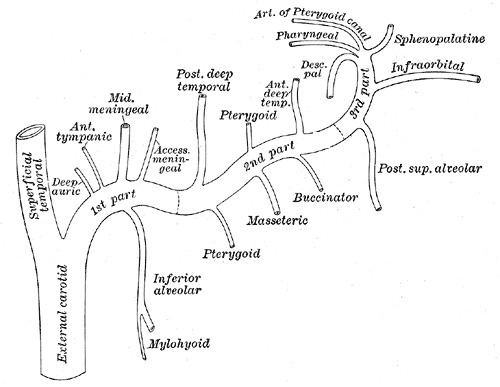Source maxillary artery Dorlands
/Elsevier a_61/12153421 | Supplies dental alveolus TA A12.2.05.056 | |
 | ||
Branches incisor branch
mental branch
mylohyoid branch Latin arteria alveolaris inferior | ||
The inferior alveolar artery (inferior dental artery) is an artery of the face.
Contents
Origin
The inferior alveolar artery is one of five branches of the first part of the maxillary artery. After branching, it descends downwards and forwards to join the inferior alveolar nerve.
Course
It descends with the inferior alveolar nerve to the mandibular foramen on the medial surface of the ramus of the mandible.
It runs along the mandibular canal in the substance of the bone, accompanied by the nerve, and opposite the first premolar tooth divides into two branches, incisor and mental.
Incisor branch
The incisor branch is continued forward beneath the incisor teeth as far as the middle line, where it anastomoses with the artery of the opposite side
The inferior alveolar artery and its incisor branch during their course through the substance of the bone give off a few branches which are lost in the cancellous tissue, and a series of branches which correspond in number to the roots of the teeth: these enter the minute apertures at the extremities of the roots, and supply the pulp of the teeth.
Mental branch
The mental branch exits the mandible with the mental nerve at the mental foramen, supplies the chin, and anastomoses with the submental and inferior labial arteries.
Mylohyoid branch
As the inferior alveolar artery enters the foramen, it gives off a mylohyoid branch which runs in the mylohyoid groove, and supplies the mylohyoid muscle.
